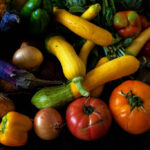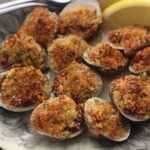Minestrone
For many decades, this great vegetable soup—a specialty of Liguria, in the northwest of Italy—has been the headliner soup over here, both in Italian-American restaurants and simmering in the pot of many an Italian-American grandma. There are multifarious forms of it, both there and here, but the American minestrone most typically includes tomatoes, beans, cabbage and small pasta. The following version—one of the most haunting and delicious I’ve ever had anywhere—owes its success to the inclusion of a rind of Parmigiano-Reggiano in the soup pot (which deepens the flavor immeasurably), and a last-minute swirl of basil, garlic and oil (sort of a thin pesto, recalling both Liguria, and the pistou that’s swirled into a similar soup in the south of France.)
serves 6
1 cup good quality extra-virgin olive oil
1 medium leek, pale green and white parts only, split, washed and sliced ½” thick (about ⅔ cup)
1 small onion, cut into ½” pieces (about ½ cup)
2 small carrots, peeled and cut into ½” pieces (about ⅔ cup)
1 small russet potato, peeled and cut into ½” pieces (about ¾ cup)
1 small zucchini, cut into ½” pieces (about ⅔ cup)
6 large cloves of garlic, plus 2 additional large cloves of garlic, minced
4 tablespoons tomato paste
1 small head escarole, washed and chopped coarsely (about 2½ cups, loosely packed)
½ small head Savoy cabbage, cored and chopped coarsely (about 4 cups, loosely packed)
a 28-ounce can of tomatoes, chopped coarsely and drained
5 cups chicken stock
5 cups water
rind of Parmigiano-Reggiano cheese (about 5″x 5”), plus 3 ounces Parmigiano-Reggiano for grating
1 cup firmly packed fresh basil leaves, rinsed, dried and chopped finely
¾ cup ditalini, small elbow macaroni, or other small pasta shape
a 14-ounce can of navy or cannellini beans, drained and rinsed
1. Place ½ cup of the olive oil in a large stockpot over high heat. Add the leek, onion, carrot, potato, zucchini and 6 minced cloves of garlic. Cook without stirring for about 4 minutes to allow the vegetables to begin browning. Reduce the heat the medium-high and continue cooking, stirring occasionally until the edges have begun to turn golden, reducing the heat if they threaten to burn, about 5 or 6 minutes more.
2. Add the tomato paste and cook for an additional 2 minutes, stirring regularly.
3. Add the escarole, cabbage, tomatoes, chicken stock, water and cheese rind, and bring to a boil over high heat. Taste for seasoning (if your stock is not salty, you may need as much as 2 teaspoons of salt). Reduce to a bare simmer and cook for 45 minutes, stirring occasionally.
4. Meanwhile, in a small bowl, combine the remaining 2 cloves of minced garlic, the remaining ½ cup of olive oil and the basil. Blend well. Cover with plastic and set aside.
5. After the soup has cooked for 45 minutes, stir in the small pasta and cook for 5 minutes. Stir in the beans. Taste the broth and adjust the seasoning with salt. When the pasta is just cooked through, ladle the soup into large bowls and garnish each serving with a heaping tablespoon of basil-garlic oil, dribbled over the entire surface. Grate a tablespoon of cheese in the center of each bowl and serve, passing the grater with the remaining cheese at the table.
And the wine…
NV Cantina di Sorbara Viola d’Autunno, Lambrusco di Sorbara (DOP) ($15)
 “What to drink with soup?” is an age-old question in the pairing world; soup has long been perceived as difficult for wine…because matching a liquid with a liquid seems redundant.
“What to drink with soup?” is an age-old question in the pairing world; soup has long been perceived as difficult for wine…because matching a liquid with a liquid seems redundant.
A great strategy, on the chef’s side, is to make the soup chunky. A consommé is much more difficult to match than a chunky minestrone; the latter gives wine much more “to grab on to.”
As for wine strategy…well, soup-bound sommeliers often resort to wines that have texture “irregularities” about them. No light Muscadet on light consommé here. You need a heavier wine, for example, this is one reason why Madeira, with the heft of 18% alcohol, became a traditional soup-mate.
Champagne as well—and other sparkling wines—are also popular with soups. The zip of bubbles makes the liquid in the glass seem a contrast to the liquid in the bowl.
It is in this spirit that I offer with the minestrone, one of my favorite sparkling wines for food in the whole world: dry, red, fizzy stuff from Emilia-Romagna. This particular match is ideal: the hearty minestrone is “cut” both by the wine’s bubbles and the wine’s acidity.
As most Lambrusco di Sorbaras are (see yesterday’s post), Cantina di Sorbara’s is an extremely light color: a very faint purple-red, but the key word is faint. Lovely plum nose jumps out of glass, with a little blueberry…not to mention Christmas candies! Quite dry, but with a nervous sugar-acid interplay (just a little sugar). Fruit is ripe-tasting, very satisfying. Bubbles are not forceful, but fun and racy in your mouth. Lingering finish of cranberry and citrus flavors. Delightful stuff as an aperitif, or with a wide range of foods. Start your meal with salumi and Sorbara…then move on to minestrone and Sorbara! And something off the grill—Italian fresh sausage?—wouldn’t be a bad main course follow-up! Also with the Lambrusco di Sorbara!



